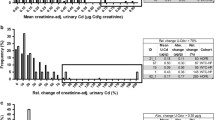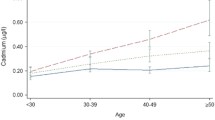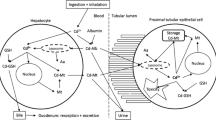Summary
A previous study concluded that there are some doubts as to the validity of creatinine as a parameter for adjusting the values of biological indicators determined on spot samples of urine, since it is subject to marked inter- and intraindividual variations. Furthermore, since there was only a moderate correlation between creatinine levels and specific density, it can be assumed that these two parameters cannot be used indifferently for adjustment. Nevertheless, it seemed advisable to verify whether correction of cadmium values determined from spot samples offers any practical advantages. For this purpose, 105 subjects with occupational exposure to cadmium were examined. They collected their 24-h urine and spot samples separately at 8.00 h. There was a close correlation between CdU/spot samples and CdU/24 h. The correlation index was very similar both for CdU/spot values expressed in μg/l and for values adjusted according to creatinine or 1024 specific gravity. These results show that no particular advantages are offered by adjusting CdU according to creatinine or specific gravity.
Similar content being viewed by others
References
Alessio L, Odone P, Bertelli G, Foa' V (1983) Cadmium. In: Alessio L, Berlin A, Roi R, Boni M (eds) Human biological monitoring of industrial chemicals. Commission of the European Communities, Luxemburg, EUR 8476 EN
Alessio L, Berlin A, Dell'Orto A, Toffoletto F, Ghezzi 1 (1985) Reliability of urinary creatinine as a parameter used to adjust values of urinary biological indicators. Int Arch Occup Environ Health 55
Castoldi MR, Calzaferri G, Odone P, Dell'Orto A, Zocchetti C, Alessio L (1983) Behaviour of cadmium biological indicators in subjects living in the Milan area. Med Lav 74:442–452
Elinder CG, Kjellstrom T, Linman L, Pershagen G (1978) Urinary excretion of cadmium and zinc among persons from Sweden. Environ Res 15:473–484
Elkins HB, Pagnoto LD, Smith HL (1974) Concentration adjustment in urinalysis. Am Ind Hyg Ass J 35:559–565
Friberg L, Kjellstrom T, Nordberg G, Piscator M (1979) Cadmium. In: Friberg L, Nordberg G, Vouk V (eds) Handbook on the toxicology of metals. Amsterdam, Elsevier, North Holland Biomedical Press
Ghezzi I, Toffoletto F, Sesana G, Fagioli MG, Micheli A, De Silvestro P, Alessio L (1983) Proceedings International Conference. Heavy metals in the environment. Heidelberg, pp 58–61
Jaffé M (1986) Über den Niederschlag, welchen Pikrinsäure im normalen Harn erzeugt und über eine neue Reaktion des Kreatinins. Z Physiol Chem 10:391–400
Kubasik NP, Volosin MT (1973) A simplified determination of urinary cadmium, lead and thallium with use of carbon rod atomisation and atomic absorption spectrophotometry. Clin Chem 19:954
Lauwerys R (1982) The toxicology of cadmium. CEC report, EUR 7649 EN
Pryde DE (1982) Is it appropriate to adjust the results of urine analysis for concentrationdilution effects? Proceedings International Workshop on Biological Indicators of Cadmium Exposure “Diagnostic and Analytical Reliability”. CEC IUPAC, Luxemburg
Author information
Authors and Affiliations
Rights and permissions
About this article
Cite this article
Berlin, A., Alessio, L., Sesana, G. et al. Problems concerning the usefulness of adjustment of urinary cadmium for creatinine and specific gravity. Int Arch Occup Environ Health 55, 107–111 (1985). https://doi.org/10.1007/BF00378372
Received:
Accepted:
Issue Date:
DOI: https://doi.org/10.1007/BF00378372




